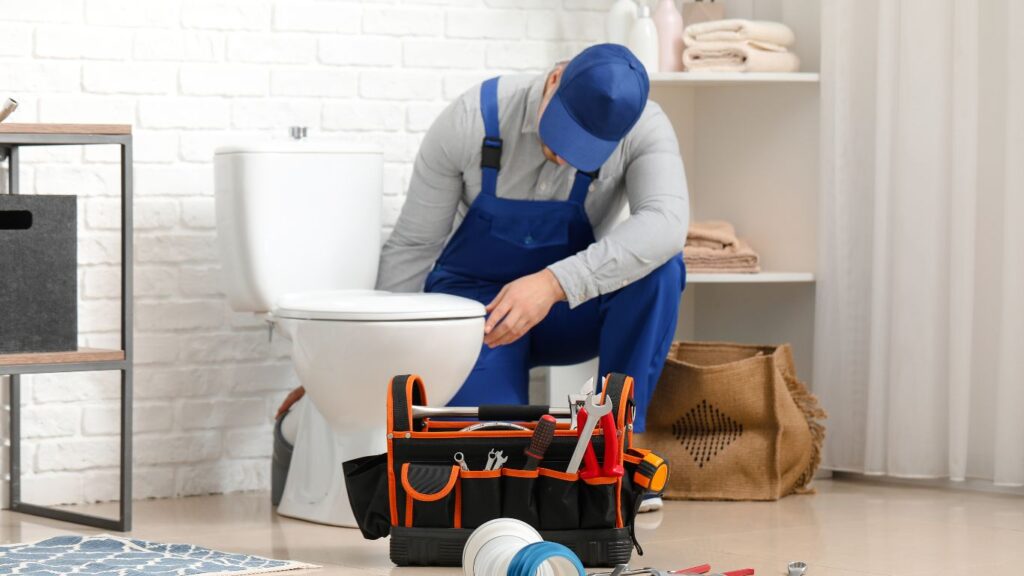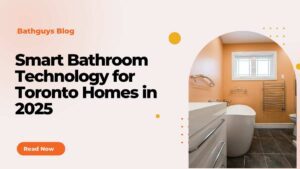As our parents or older family members age, simple daily tasks—like using the bathroom—can become difficult or even dangerous. Slippery floors, tight spaces, and high bathtubs can lead to accidents, making it harder for them to stay safe and independent at home. That’s why creating a bathroom that’s easy and safe to use is so important.
In this blog, we’ll explore how accessible bathroom design for aging parents or family members can help improve comfort, safety, and peace of mind—especially for families living in Toronto and the GTA. From grab bars to walk-in showers and smart layouts, you’ll discover practical tips to make your bathroom senior-friendly without giving up on style. Whether you’re planning ahead or making changes now, this guide will help you take the right steps.
Table of Contents
Why Accessible Bathroom Design Matters

- Improves Safety for Seniors
Slippery tiles, high tubs, and awkward layouts can lead to serious falls and injuries. An accessible bathroom design for aging parents or family members reduces these risks by including safety features like grab bars, non-slip flooring, and walk-in showers. - Promotes Independence
A well-designed accessible bathroom allows older adults to use the space without constant assistance. Features like lever-style faucets, raised toilets, and easy-reach storage help maintain their independence and dignity. - Supports Aging in Place
More Canadian families prefer aging in place over assisted living. Accessible bathrooms play a key role in allowing seniors to stay comfortably in their homes longer, especially in areas like Toronto and the GTA. - Reduces Caregiver Stress
When a bathroom is adapted for mobility needs, caregivers spend less time assisting and worrying about accidents. This design shift helps ease the mental and physical load on family members or hired professionals. - Increases Home Value
Homes with senior-friendly or universally accessible features appeal to a wider market. In the Toronto real estate scene, accessible bathroom remodels can boost resale value while adding long-term practicality. - Compliance with Building Codes & Accessibility Standards
Following accessibility guidelines like the Ontario Building Code ensures your renovation is up to standard. It also guarantees safer and more functional outcomes for those with reduced mobility. - Better Comfort for All Users
Accessible design doesn’t just benefit seniors—it creates a better experience for everyone. Wider doorways, better lighting, and smart layout planning can improve usability for all ages and abilities.
Key Design Principles & Universal Design Features
- Zero-Threshold Showers
Eliminate tripping hazards by opting for a curbless or roll-in shower. This design is essential in accessible bathroom design for aging parents or family members, allowing easy entry for those using walkers or wheelchairs. - Non-Slip Flooring
Choose slip-resistant tiles or textured vinyl flooring to reduce fall risks. Non-slip surfaces are a universal design feature that protects everyone, not just seniors. - Wider Doorways and Clear Floor Space
Aim for a minimum doorway width of 34 inches to accommodate mobility aids. Also, ensure there’s enough open space for turning and maneuvering—especially near sinks, toilets, and showers. - Lever-Style Faucet Handles
Replace traditional knobs with lever handles or touchless faucets. These are easier for individuals with arthritis, limited grip strength, or dexterity issues. - Comfort-Height Toilets
Install raised or comfort-height toilets (17–19 inches high) to reduce strain when sitting or standing. Consider adding grab bars beside the toilet for extra support. - Wall-Mounted or Floating Vanities
These offer wheelchair users better knee clearance and help create a clean, spacious look. Add pull-out drawers and open shelving for easy access to essentials. - Ample Lighting with Motion Sensors
Good lighting reduces eye strain and prevents accidents. Use layered lighting—overhead, task, and night lighting—with motion sensors for hands-free operation. - Reinforced Walls for Grab Bars
During the renovation, reinforce walls near toilets and showers to safely mount grab bars later. This is a smart long-term solution, even if you don’t install them immediately. - Adjustable Showerheads and Handheld Sprays
A flexible showerhead with a sliding bar or handheld spray allows users of all heights and mobility levels to shower comfortably. - Smart Layout Planning
Place fixtures in intuitive, reachable spots. Avoid placing towel racks or soap dishes too high or far from seated positions. Prioritize flow and function.
Accessible Fixtures Breakdown

- Walk-In Bathtubs
Ideal for seniors and individuals with mobility issues, walk-in tubs feature low-entry thresholds, built-in seating, and grab bars. They make bathing safer and more comfortable in accessible bathroom design for aging parents or family members. - Grab Bars and Support Rails
Install stainless steel or anti-slip grab bars near toilets, showers, and bathtubs. These essential safety fixtures help prevent falls and provide added stability for elderly family members. - Raised Toilets
Often referred to as comfort-height toilets, these sit 2–3 inches higher than standard models. They reduce the strain on knees and back, making sitting and standing easier. - Adjustable Showerheads
Handheld or height-adjustable showerheads are perfect for people with varying mobility levels. They offer flexibility and make personal hygiene more manageable and safe. - Anti-Scald Valves
These safety fixtures regulate water temperature to prevent accidental burns. They are especially crucial in homes with elderly family members who may have slower reaction times. - Touchless Faucets
Motion-sensor faucets reduce the need to twist or turn handles. They are great for individuals with arthritis or limited hand strength, promoting hygiene and ease of use. - Accessible Sink Designs
Wall-mounted or wheelchair-accessible sinks offer better knee clearance and easy reach. Pair them with easy-pull drawers and open shelving for added convenience. - Tilted Mirrors
Adjustable or angled mirrors ensure visibility for seated users and wheelchair-bound individuals. This simple addition makes daily grooming more inclusive. - Non-Slip Mats & Flooring
Incorporate slip-resistant tiles or vinyl flooring and secure rubber mats around wet areas. This prevents slipping hazards and enhances overall bathroom safety. - Smart Toilet Features
Consider high-tech additions like heated seats, bidet functions, and remote controls. These upgrades boost comfort and independence for aging adults.
Local Regulations & Contractor Insights in Toronto/GTA
- Follow Ontario Building Code (OBC) Standards
All accessible bathroom renovations in Toronto and the GTA must comply with the Ontario Building Code, which outlines minimum requirements for accessibility, including barrier-free entryways, grab bar placement, and space allowances for mobility aids. - Understand AODA Requirements
The Accessibility for Ontarians with Disabilities Act (AODA) sets guidelines to improve accessibility in public and residential spaces. Contractors must stay informed about how these rules impact accessible bathroom design for aging parents or disabled family members. - Permit Requirements Vary by Municipality
Renovation permits may be needed depending on the scope of the project—especially when plumbing, structural changes, or accessibility upgrades are involved. Homeowners in Toronto, Mississauga, or Vaughan should check with their local building departments. - Hire Certified and Insured Contractors
Always choose licensed contractors familiar with local accessibility standards. Companies like BathGuys specialize in bathroom renovations in Toronto and are experienced in creating safe, functional spaces for elderly family members. - Customized Accessibility Planning
Local experts can assess your space and suggest tailored solutions, such as widening doorways, adjusting countertop heights, or creating level-access showers—all aligned with the specific needs of aging individuals. - Energy-Efficient and Sustainable Options Available
Many Toronto-based contractors now offer accessible bathroom fixtures that are also eco-friendly, such as low-flow toilets and LED lighting, meeting both accessibility and sustainability goals. - Incentives or Rebates May Apply
Some Ontario programs offer rebates or tax credits for accessibility renovations. It’s worth discussing with your contractor if your project qualifies under the Healthy Homes Renovation Tax Credit (when available) or municipal grants. - Work with Renovation Experts Who Know the GTA
Contractors like BathGuys understand not just design, but also the practical logistics of working within city guidelines and tight urban spaces—key for executing successful bathroom upgrades for elderly residents.
Cost Estimates & Value for GTA Homeowners
- Average Cost of an Accessible Bathroom Renovation
In Toronto and the GTA, a standard accessible bathroom renovation for aging parents typically ranges from $15,000 to $30,000, depending on materials, layout changes, and fixture upgrades. - Factors Affecting the Total Cost
Costs vary based on factors such as the size of the bathroom, the complexity of modifications, and the quality of finishes. Custom features like walk-in tubs, roll-in showers, and non-slip flooring can increase the overall budget. - Return on Investment (ROI) Potential
Accessible bathrooms often increase a home’s resale value, especially in aging-friendly communities. Adding universal design elements improves both functionality and long-term livability, making your home more marketable. - Long-Term Savings on Healthcare Costs
By improving safety and accessibility, families may reduce the risk of falls and injuries, potentially avoiding future medical expenses or the need for assisted living services. - Budget-Friendly Tips for GTA Homeowners
- Prioritize essential features like grab bars, lever faucets, and barrier-free showers.
- Reuse existing plumbing locations to save on relocation costs.
- Choose durable, mid-range materials that balance affordability and longevity.
- Prioritize essential features like grab bars, lever faucets, and barrier-free showers.
- Grants and Financial Support in Ontario
Programs like the Home and Vehicle Modification Program (HVMP) or municipal retrofit rebates may help eligible homeowners cover some costs. Ask your contractor if you qualify. - Work with Local Specialists Like BathGuys
Hiring experienced bathroom renovators in Toronto ensures transparent pricing, accurate estimates, and cost-effective solutions tailored for aging family members. - Invest in Safety, Gain Peace of Mind
While upfront costs may seem high, the long-term value of a well-designed accessible bathroom includes safety, comfort, and greater independence for elderly or mobility-challenged family members.
Conclusion
Designing an accessible bathroom for aging parents or family members isn’t just about meeting mobility needs—it’s about creating a space that offers safety, dignity, and long-term comfort. In the Toronto and GTA region, homeowners are increasingly embracing universal design features like barrier-free showers, comfort-height toilets, and non-slip flooring. With the right planning, cost-effective choices, and support from a trusted contractor like BathGuys, you can ensure your renovation meets current needs while also adding value to your home. An accessible bathroom remodel is a smart investment for aging-in-place solutions and improved quality of life. Prioritize safety, functionality, and thoughtful design to support your loved ones in every stage of life.
FAQs
What is the best layout for an accessible bathroom for seniors?
The ideal layout includes open floor space for wheelchair or walker movement, a curbless shower, and a toilet placed near grab bars. Keeping pathways clear and ensuring enough turning radius are essential for safe navigation.
Are there government grants in Ontario for accessible bathroom renovations?
Yes, programs like the Ontario Renovates Program or the March of Dimes’ Home & Vehicle Modification Program may offer financial assistance. These grants can help reduce the cost of accessible upgrades for eligible homeowners.
What are essential features in an elderly-friendly bathroom?
Key features include non-slip floors, walk-in tubs or roll-in showers, grab bars, raised toilet seats, lever-style faucets, and adequate lighting. These elements improve safety, comfort, and ease of use.
How much does an accessible bathroom renovation cost in Toronto?
On average, accessible bathroom renovations in Toronto and the GTA range from $15,000 to $30,000. The cost depends on the size of the space, materials used, and specific accessibility features included.
Can a standard bathroom be converted into an accessible one?
Yes, most traditional bathrooms can be modified for accessibility. Common conversions include widening doors, installing grab bars, replacing the tub with a barrier-free shower, and adjusting the height of fixtures.





